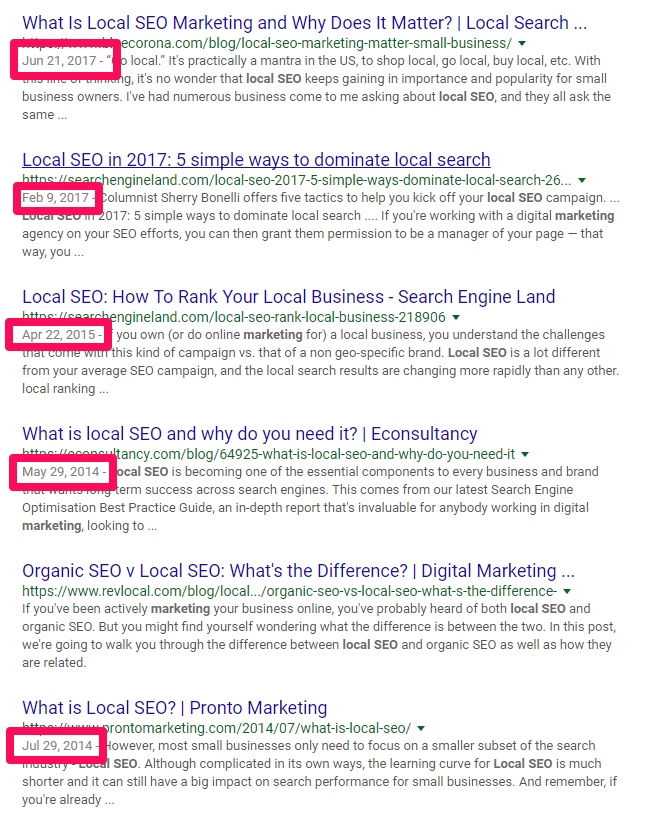SEO never stops.
It seems like every month a ‘best practice’ gets turned upside down.
It doesn’t help that Google is constantly tweaking their algorithm.
Or the fact that we only know a few ranking factors with any degree of certainty.
The fact of the matter is that we may never know if these tactics are as important as we think (or read).
The only real way to find out what works is to take matters into your own hands.
Here’s how to put your current SEO tactics to the test with these four experiments.
1. Internal Linking Shouldn’t Be an Afterthought
Internal links are usually reserved as a box that most people check on their on-page optimization checklists.
Just another task to knock off before publishing, with no rhyme or reason.
Add three? Yup. Like an afterthought.
While internal linking isn’t a direct ranking factor, that’s not to say it should be relegated to the SEO minor leagues, either.
A few keyword-heavy, anchor text links isn’t the point.
Think less on-site optimization, more site architecture.
An excellent example comes from Graham Charlton on Search Engine Watch.
A few years ago during the FIFA World Cup, sites like Mail Online and The Guardian were trying to capitalize on spiking organic searches.
Mail Online and The Guardian at the time had comparable authority. Traffic and competition were fairly similar.
However, in Google searches for the “World Cup,” The Guardian ranked in the top 10 results for over four months before (and multiple months after) the event.
And Mail Online, featuring nearly the same content, didn’t rank higher than the fourth page of “world cup” searches.
Yikes.
Doesn’t make sense. Does it?
When you dive deeper into the structure of each post, you start to see issues.
The Guardian’s post used the content as a centralized hub to link to all their World Cup-related content.

On the other hand, Mail Online was posting dozens upon dozens of content around the World Cup.
Except, they often didn’t link back to each other, providing Google zero context between them.
Now, obviously, this isn’t a foolproof, error-free, variable-less study.
But it does prove one specific point:
Hub pages still matter.
Internal links aren’t just for optimizing that page, as they are for optimizing the pages around them.
Contextual relevance is the goal. Not some artificial number.
2. Don’t Forget About Giving Outbound Links, Either
Internal links are important.
But external ones are where the gold lies.
Sometimes, though, acquiring links naturally seems nearly impossible.
Why? They matter. Sites don’t want to hand them out like candy and risk increasing their own competition.
Maybe that’s exactly what they should be doing, though.
Some people get hesitant to hand out backlinks even to relevant sources or competitors. However, that hesitancy can impact your own rankings in surprising ways.
Check out this study from Reboot on outgoing links as a ranking signal.
They invented a fake search term that had zero search results on Google, called “Phylandocic.”
They verified the word had no rankings or relevant search results because they wanted to see what the impact of authoritative outbound links would have on increasing their own rankings.
Next, they built 10 sites and created 300-word articles – complete with their new favorite keyword.
Each site had comparable structure and authority, except for one key factor: authoritative outbound links.
On half of the sites, they included three authoritative links from Oxford University, Cambridge, and the Genome Research Institute.
And the results speak for themselves.
The five sites that linked to three authoritative sources ranked in the top five results. The other five without outbound external links ranked lower in the search results.
Their final statement on the testing summed it up best:
“Outgoing relevant links to authoritative sites are considered in the algorithms and do have a positive impact on rankings.”
So, what can you take away from this experiment?
Start by citing more authoritative sites, studies, or scholarly posts. Google Scholar can help you quickly locate several that can be plugged into a page within seconds.

3. Refreshing Old Content – Does It Work?
You can’t go a day without reading a marketing article that was “updated” a month or two ago.
New tactics were added, more relevant images included, just-released statistics included, too.
Currently, there a few generally-accepted ways to refresh an old post to appear new.
For example, you can change the date right within your content management system to reflect a new publish date. Or, you can add a side-note at the beginning of your content reflecting when it was updated:
This post was last updated on X/X/XXXX to reflect XX.
In today’s landscape, everything we consume is new.
Google has put a major focus on news and breaking stories. Content that has “fresh” info or relevance to today, not yesterday.
One would expect that an SEO tips post from 2001 wouldn’t rank well compared to the 2017 edition.
But is that really true?
And if it is, does updating old posts raise your rankings?
Or do you need to create an entirely new post?
2 Dogs Media put this to the test with their own study that tested keyword rankings for specific pages after making changes to their publish date or updated date.
In multiple basic tests, they found that some pages increased in rankings only when the published or updated date was changed. In others, they found no significant impact either way.
Generally speaking, it didn’t do any harm, and the general outcome was a slight increase in rankings.
Shout Me Loud conducted a similar test on the effect of date stamps on their traffic. In this case, leaving the old content dates caused massive traffic and keyword drops.
While this probably isn’t a direct ranking factor, it’s likely an indirect one.
Why? The user experience.
Conduct a basic Google search for a topic and analyze the SERPs. What do you see?

Usually, depending on the topic, you will see that updated posts tend to rank higher. And this is likely due to the fact that people want the most updated, relevant posts.
A simple tweak in the publish date can give your content even just the appearance of being new, which may be enough to increase your organic click-through rate.
Results based on refreshing your old content can vary. But freshness will only become more influential as the number of new content continues to rise exponentially.
- Update the publish date each time you add new content to the original.
- Update old links in your post if the content has changed since its original publish date.
- Update outdated information, statistics, etc. that are no longer relevant.
- BUT, don’t change concrete principles that haven’t changed, solely for the sake of making them fresh. This might actually hinder your rankings.
4. The Age-Old Debate of Quality vs. Quantity
The more content, the better. Right?
Well, not always.
HubSpot’s blogging frequency benchmarks show a clear picture that the more often you post, the more traffic you get. Not only does that get you more traffic, but it obviously adds more indexed pages and therefore, more leads.
While it may seem logical to assume that more content = more indexed pages = more leads = more rankings for more keywords, it’s not all sunshine and daisies.
Brian Dean of Backlinko is a perfect testament to the failure of standard frequency benchmarks. In just the last five years, he’s only posted 53 blog posts. But those 53 posts have driven over four million visitors to his site.
The average post gets thousands of shares and hundreds of unique backlinks. His frequency is obviously nowhere near the 16+ a month that HubSpot recommends, yet he is generating incredible traffic numbers.
Buffer was able to increase their own traffic and engagement by reducing the quantity of Facebook posts. Instead, they focused on quality, netting 3x more reach and 2x more engagements.
Reducing the amount of content you publish may limit your reach if you don’t have established authority yet, but it could also improve the overall quality of your site.
When new users find your content, you can be sure that they will engage with it and love the content. Just pumping and dumping content on your blog leaves huge room for error and topics that aren’t covered well. So when a new user lands on your post, it might be sub-par.
And last time I checked, sub-par content doesn’t land leads.
When it comes to your blog, your rankings, and your traffic, start testing frequency patterns.
Set aside a few months to really experiment with how often you post on your blog. Make that your main focus and track your analytics for overall site traffic as well as each individual post.
It might just be the difference maker in your traffic numbers.
Conclusion
SEO is brutal.
Hundreds (if not thousands) of individual variables make up ranking factors.
We think. We’ve been told. But nobody knows for sure.
With most things in SEO, you won’t know until you try. Or in this case, experiment with it.
‘Best practices’ don’t apply to everyone.
Especially, as in SEO, Google never confirms or denies.
More SEO Resources:
- SEO 101: Learn the Basics of Search Engine Optimization
- A Complete Guide to Getting Started in SEO
- 101 Quick & Actionable SEO Tips That Are HUGE
Image Credits
Featured Image: PublicDomainPictures/Pixabay.com
Screenshots by Brad Smith. Taken February 2018.


